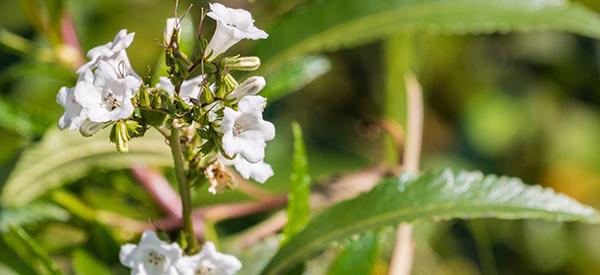
Yerba Santa
Yerba Santa (Eriodictyon californicum) is a native California and Oregon medicinal plant with a Spanish name that means “sacred herb.” The plant earned its name for its potency in healing many medical problems. This aromatic shrub bears a cluster of creamy white and purple flowers that produces the nectar essential for variable checkerspot butterflies. Yerba Santa has a distinctly pleasant smell and a bitter tang that ultimately turns into a sweet, bubble gum-like taste.
In ancient spiritual rituals, Yerba Santa was used as a smudge that clear heavy and dark energies from people. Smudge or smudging is the traditional act of burning natural medicines to purify the body, mind, and soul. The Yerba Santa plant is considered an effective herb for clearing away negativity in people and improving their spiritual health.
The history of the Yerba Santa is anchored in the religious quintessence for thousands of years. Native Americans have long been using the herb in medicinal practices. When Spanish missionaries came to America, they discovered the ability of the Yerba Santa in treating respiratory illnesses. It was highly revered for its potency that Spanish priests considered it as a holy herb.
Where The Plant Is Found
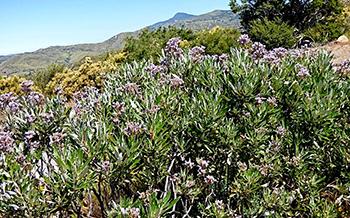 Yerba Santa is a perennial and woody shrub native to Canada and Oregon. It is found in Arizona, Nevada, and Northern Mexico. Yerba Santa grows in chaparrals and coast redwood forests. It also occurs in dry, hilly, rocky slopes and ridges and can survive even in disturbed communities. Yerba Santa is also known as mountain balm, bear’s weed, gum plant, and consumptive weed.
Yerba Santa is a perennial and woody shrub native to Canada and Oregon. It is found in Arizona, Nevada, and Northern Mexico. Yerba Santa grows in chaparrals and coast redwood forests. It also occurs in dry, hilly, rocky slopes and ridges and can survive even in disturbed communities. Yerba Santa is also known as mountain balm, bear’s weed, gum plant, and consumptive weed.
Related: The Complete Map of Edible Plants: Find Out What You Have in Your Area! (Video)
How To Identify Yerba Santa
The sacred herb is a low and erect evergreen plant. It grows attractive flowers which attract bees and butterflies that produce spicy amber honey. Yerba Santa is an attractive plant ideal for landscape gardens, especially those that are prone to soil erosion. The genus Eriodictyon or woolly net in Greek refers to the fuzzy underside of the Yerba Santa’s leaves.
 Leaves. Yerba Santa leaves are tough and leathery with a simple lance or oblong shape. It has smooth green to yellowish hue with its upper side coated in varnish-like resin that makes it look shiny. The underside is also yellowish-white with a network of markings and felt-like hairs.
Leaves. Yerba Santa leaves are tough and leathery with a simple lance or oblong shape. It has smooth green to yellowish hue with its upper side coated in varnish-like resin that makes it look shiny. The underside is also yellowish-white with a network of markings and felt-like hairs.- Flowers. The flowers of the sacred herb which blooms from July to August have white to pale lavender colors. These are shaped like little trumpets arranged in terminal clusters of 6 to 10 flowers. Each flower measures about 1 to 2 cm long and appears just above the leaves.
- Roots. Yerba Santa roots are shallow, but they are multi-branching rhizomes that easily spreads underground. The main roots of the holy herb are often found at only about 3 inches deep in the soil.
- Seeds. The small, capsule-shaped fruit of this plant will produce around 2 to 20 black seeds. Yerba Santa seeds are fire-follower that germinates after wildfire events. It means that the seeds lying dormant for decades will germinate after a fire disturbance.
- Stem. A glutinous resin covers all the upper parts of the Yerba Santa plant. Its stems are smooth and are branched near the ground. The lower branches are usually woody and with shredding outer Eriodictyon californicum bark. Yerba Santa shrubs will grow at around two to eight feet tall.
Related: Plant Identification Guide – 400 Wild Plants That You Can Forage For (Video)
Yerba Santa has around 16 species distributed in California and Oregon. The most widely occurring are the Eriodictyon califonicum. But other popular varieties are:
- Eriodictyon angustifolium or narrow-leaf Yerba Santa
- Eriodictyon crassifolium or thick-leaf Yerba Santa
- Eriodictyon trichocalyx or hairy Yerba Santa
How To Grow Yerba Santa
Yerba Santa can be cultivated as an ornamental shrub and is easy to grow in a conducive environment. They are well-acclimated to the Mediterranean climate and are tough enough to grow in sun-blasted locations.
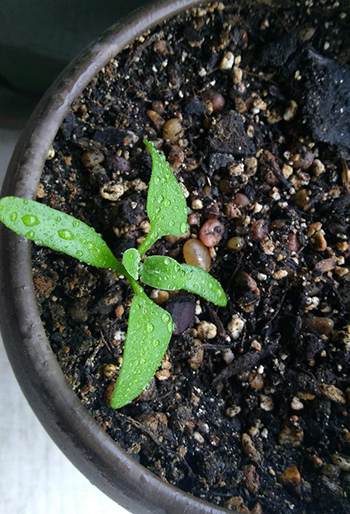 Yerba Santa thrives in USDA Hardiness 7 to 10.
Yerba Santa thrives in USDA Hardiness 7 to 10.
The Yerba Santa plant can propagate either through its seeds or sprouting rhizomes. Over time, the rhizomes will spread and form a colony.
The seeds of Yerba Santa are available in many seed stores online. Local nurseries may also have this sacred herb growing and ready for transplanting.
Early spring is the best time to plant Yerba Santa. Seeds for sowing are soaked in water overnight. Other gardeners use the smoked water treatment for germinating seeds. They may also apply direct heat to char the seeds and hasten the germination. Yerba Santa seeds will germinate for 20 to 60 days.
You can sow Yerba Santa in the garden or containers with an equal mixture of sand, soil, and leaf molds. Place the seeds on the slightly moist mixture and tamp the soil down. Make sure that the area or container gets full sun and stays warm. Water the potting mix only when the surface gets dry. When planting it in a container, you may transplant Yerba Santa in larger pots.
Related: 10 Plants That You Should Never Plant Together (Video)
Heat Treatment for Yerba Santa
Yerba Santa is a fire-following plant with a unique germination process. This fire-adapted plant may sometimes have a hard time germinating and growing. One trick that seasoned gardeners use is passing the seeds through a fire.
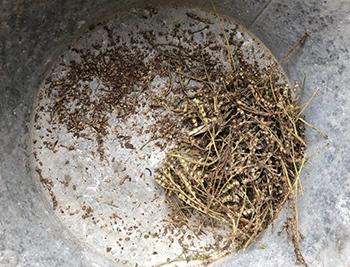
Here are some unique ways of germinating a Yerba Santa:
- Adding charred wood into the potting mix.
- Heating the seeds in an oven at 190F for 5 minutes.
- Placing the seeds in hot water between 180 to 200°F.
- Mechanical scarification or scraping of seeds
Growing Yerba Santa from Rhizomes
The sprouting underground rhizomes of Yerba Santa are capable of regenerating themselves after an episode of fire. Some species of Yerba Santa in the wild will grow by adding charate into the soil. Charate is charred woods that contain leachable chemicals that mimic the reaction of soil after a wildfire.
Plant Care and Maintenance
Yerba Santa is fairly easy to maintain once the plant is already well-established. It is fire-resistant, drought-resistant, and deer-resistant and tends to get dominant in its locality. This residual soil colonizer is also a survivor in many disturbed communities.
Maintenance of Yerba Santa is fairly easy. It will need the following conditions to flourish lushly: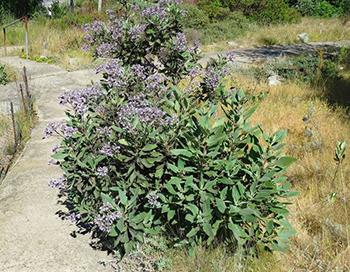
- Full sun to part shade
- Well-drained sandy-loamy soil
- Little irrigation in summer
Keep in mind that Yerba Santa reproduces vegetatively through its rhizomes. In two years, it may overwhelm the garden and overrun other plants. So, consider your location wisely before planting, or better yet, plant it in large individual containers.
How To Harvest Yerba Santa
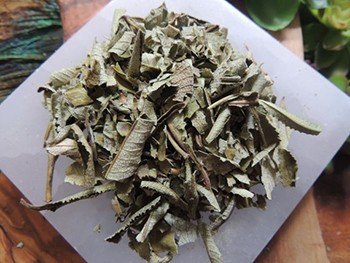 Harvesting the leaves of Yerba Santa is beneficial for stimulating new growth. Gather the vibrant new growth sometime in the early to late summer. You may cut the upper part of the twig just above a bud to encourage lush growth.
Harvesting the leaves of Yerba Santa is beneficial for stimulating new growth. Gather the vibrant new growth sometime in the early to late summer. You may cut the upper part of the twig just above a bud to encourage lush growth.
Let the stem with the attached leaves dry completely. You may lay them flat on a surface and turn them regularly to prevent the leaves from sticking together. Once the harvest is thoroughly dry, separate the leaves from the stem.
Store the leaves of the holy herb in a dry container for future tincturing, smoking, or tea use. Keep the stems in a separate container for use in smudging.
What Yerba Santa Is Good For And Natural Remedies Made From It
Yerba Santa is the saint herb of all herbs among the native Californians. It is revered as an herb with some supernatural power and hanging dried leaves in the house merits general purification. As interesting as its capability of clearing negative vibes, it is also valued for its many medicinal uses.
Yerba Santa aids in respiratory problems by reducing the inflammation of the lungs, throat, and sinuses. It also dries out excessive secretions in the upper respiratory tract to cure cough. The holy herb is also a potent herb for the treatment of tuberculosis.
This plant is also a natural remedy for digestive issues. It can relieve indigestion, acid reflux, dysentery, and stomach pain. Yerba Santa has a highly effective action as a digestive tonic and laxative.
Related: Add This “Unusual Nutrient” to Coffee or Tea, to Effortlessly and Fully Empty Your Bowels Every Single Morning (Learn More)
Various skin conditions like sores, allergies, and aging are also alleviated by Yerba Santa. It is also used as a poultice or tincture for treating wounds, insect bites, sprains, and bruises. When used in a steam bath, it is said to cure rheumatism and other joint pains.
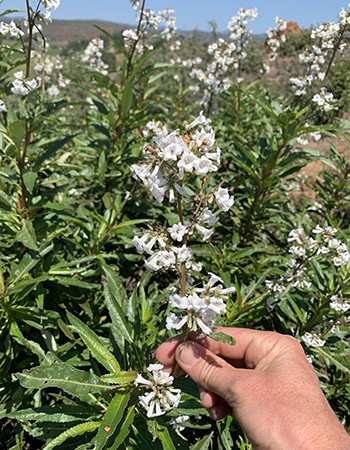
Essentially, Yerba Santa is conferred as the shrub that will treat the following body conditions:
- Respiratory problems including tuberculosis
- Digestive issues
- Joint troubles and spasms
- Skin conditions
- Mouth diseases
- Fever and colds
- Fatigue
What Parts Of The Yerba Santa Is Used For Remedies
The leaves of this plant, either dried or fresh, are used in making herbal remedies. The stem is also widely used for smudging. Its flowers are edible and can also be made into a tea or decoction with a bitter but sweet-soapy bitter taste.
Yerba Santa leaves are made into infusion or tea. It is also mashed and applied externally to wounds and for treating other skin problems. For people with fever, sticking the leaves on the forehead can reduce the bouts of headaches. You can also do this with other aching body parts to alleviate joint pain, inflammation, or spasms. The natural resin that will stick to the skin helps the Yerba Santa leaf stay in place.
As a consumptive weed, the leaves are either smoked or chewed for relieving respiratory symptoms.
Smudging or burning the twig and stem of a Yerba Santa is similar to using an incense stick. It is used for various reasons like bringing good health to an infant and protection for family members. Yerba Santa smudge bundles are also used for honoring ancestors and calming the environment.
Yerba Santa is also now available in capsules and liquid extracts, as well as dried leaves and smudging bunch.
Yerba Santa Spiritual Aid Tea
Ingredients:
- 8 oz or a mug of boiling water
- 1 tsp dried Yerba Santa
- Honey, if preferred
Steps:
- Pour the boiling water into a mug and add the Yerba Santa leaves.

- Allow the Yerba Santa infusion to steep for about 30 minutes, covered.

- Strain the leaves out from the cup, and sweeten with honey if desired.

How to Use this Remedy:
The leaves of the holy herb make a strong tea and are used for the treatment of cough and sore throat. You may also use this infusion as a tonic for stomachache and diarrhea. You may take 1 cup of tea daily until your symptoms begin to clear until about 10 days.
 Alternatively, you can put the Yerba Santa leaves in a loose tea bag. Follow the same direction as the Yerba Santa infusion. The dosage for Yerba Santa food supplements depends on the age, health, and other underlying conditions of the patient. Follow directions on the product labels and talk to your doctor before using holy herb food supplements.
Alternatively, you can put the Yerba Santa leaves in a loose tea bag. Follow the same direction as the Yerba Santa infusion. The dosage for Yerba Santa food supplements depends on the age, health, and other underlying conditions of the patient. Follow directions on the product labels and talk to your doctor before using holy herb food supplements.
If you find yourself suffering with congestion from illness or allergies, Yerba Santa is for you! It helps to loosen, expel, and dry up phlegm in the chest and sinus. What’s more, Yerba Santa helps to reduce fevers. It is one of my core medicinal herbs that I always keep on hand in a form of a tincture.
And you can buy your own Yerba Santa Tincture Here.
What Plants Resemble Yerba Santa
Warning and cautions
Yerba Santa is not recommended for pregnant and breastfeeding women due to little scientific evidence. Large doses of Yerba Santa are also damaging for the kidneys.
Yerba Santa may also interfere with drugs, herbs, and other dietary supplements. If you have an underlying condition, taking other medications or herbal medicines, talk to your healthcare provider.
Yerba Santa works like a water pill or diuretic and may increase the level of lithium in the body. Talk to your doctor if you are taking lithium medication before using Yerba Santa.
Additionally, there is no exact range of dosage for Yerba Santa due to lacking scientific evidence. When taking any herbal and food supplement always check with your doctor for your safety.
You may also like:
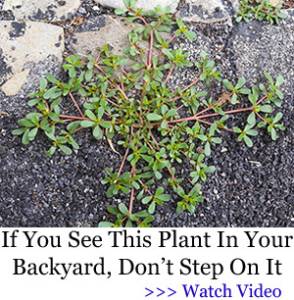 How to Make Usnea Tincture for Respiratory Support
How to Make Usnea Tincture for Respiratory Support
Do This Before Going to Bed To Rebuild Your Gums (Video)
What Bad Breath Tells You About Your Health
Best Herbs for Lungs and Respiratory Support
What Happens if You Smoke Mullein?






 Leaves. Yerba Santa leaves are tough and leathery with a simple lance or oblong shape. It has smooth green to yellowish hue with its upper side coated in varnish-like resin that makes it look shiny. The underside is also yellowish-white with a network of markings and felt-like hairs.
Leaves. Yerba Santa leaves are tough and leathery with a simple lance or oblong shape. It has smooth green to yellowish hue with its upper side coated in varnish-like resin that makes it look shiny. The underside is also yellowish-white with a network of markings and felt-like hairs.
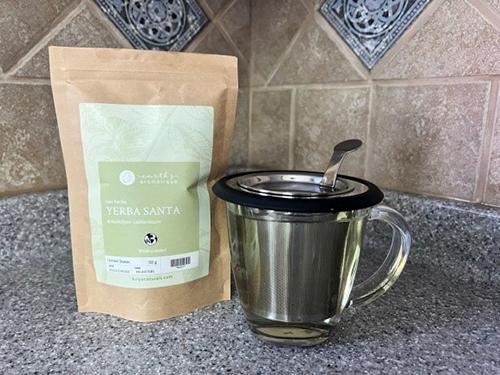
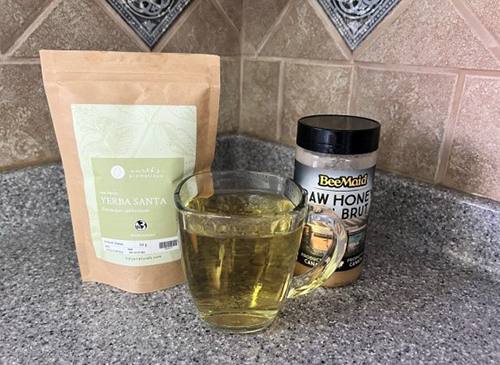
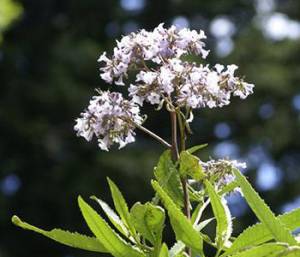
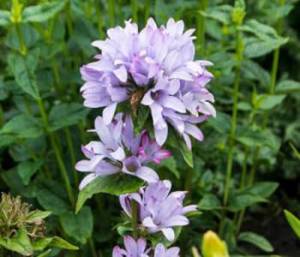
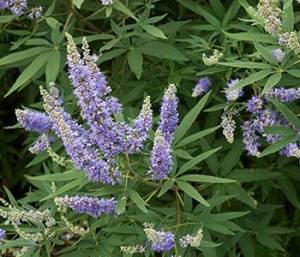
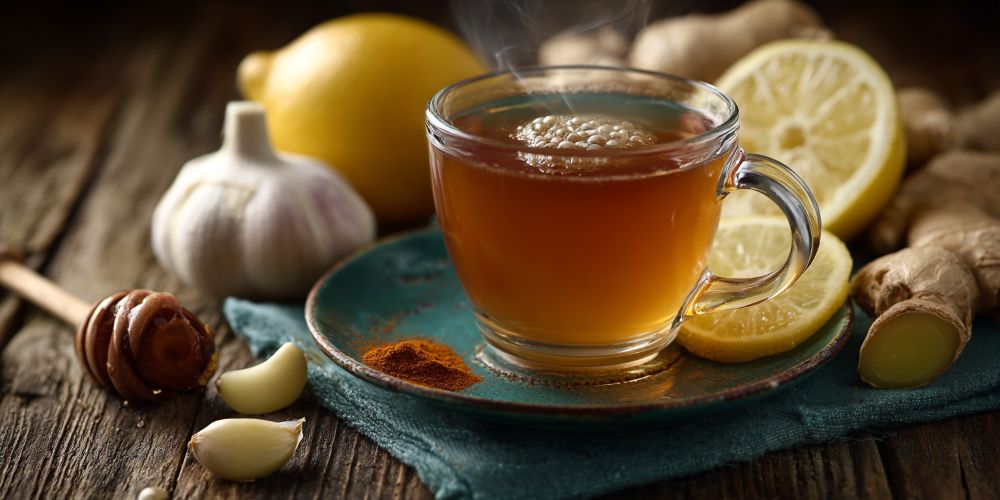
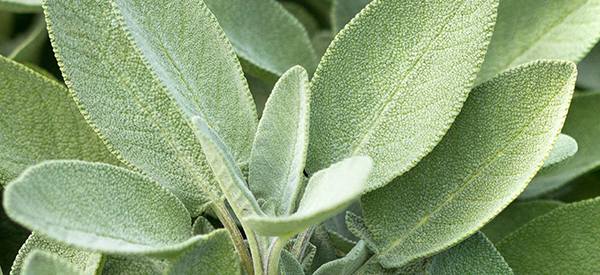

What do doctors know about herbal medicine, other than to say, “I can’t recommend it, because I don’t know about any of them?” I know you have to say that; but this herbs appears to be able to solve many of my personal issues, so I find it frustrating!
Yes, Brian, it is frustrating. When one probes deeply into the history of medicine (and ALL history, for that matter) one finds without fail an elite mass of would-be alpha primates attempting to control their respective fields–in this case medicine. (the battle between empirical and allopathic medicine). We win this battle by supporting herbalists, growers, and wise men and women holding the knowledge of the true healing without belittling or dismissing doctors not yet open to plants’ true value. Frustration leads to careful research, wise counsel, and better health. People can’t help but notice our great health–it’s infectious–and in garnering masses of those benefitting alongside us we protect the plants protecting us…